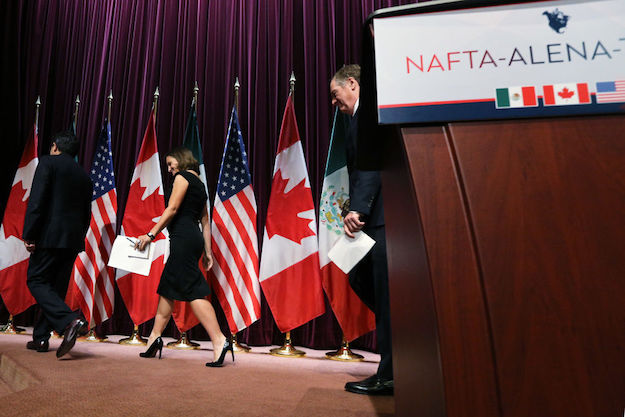When the North American Free Trade Agreement (NAFTA) was originally negotiated in 1994, four out of five of the largest U.S. companies built automobiles. Google, Facebook and Amazon hadn’t been born. E-commerce, as such, didn’t exist.
That’s part of why NAFTA renegotiations are more than just a political football: they are imperative for the region to continue its leadership in technology and commerce in the 21st century.
NAFTA 2.0 – indeed, any modern trade agreement – needs to cover issues that weren’t part of the original deal. That includes significant considerations in data and privacy protection, cyber-security, e-commerce, robotics, and artificial intelligence. Further, it must consider how all of these will affect consumer behavior, corporate strategies, job creation and skill development.
A few examples illustrate the point. Through the 1990s, IT companies outside the U.S. imported large, bulky computers from the U.S. for their data centers, requiring specialized personnel and facilities at their corporate buildings to maintain the equipment. Today that equipment is being replaced by cloud computing platforms – the corporate datacenter is no longer a place, but a service. The need to move powerful computing equipment across the border has been replaced by data that flows freely over the internet.
That provides clear tangible benefits – but also risks. Free flowing data is more vulnerable to attack than bulky shipments of physical goods. The new agreement should allow individuals and corporations to leverage cloud computing, and store their data wherever makes the most sense. At the same time, it must provide regulatory entities in the U.S., Mexico, and Canada with the certainty that this data is protected, and can be legally summoned should the need arise.
Movie and television streaming outlets are another example of dataflow that has surpassed any policies from the initial agreement. Streaming channels such as Netflix do not own broadcasting antennas, have no network affiliates, and despite a demand for enormous computing power, have no servers or data centers. Instead, they leverage cloud computing to distribute content to nearly 200 countries.
As of now, World Trade Organization members have agreed only to a temporary moratorium on imposing duties on digital products. NAFTA 2.0 should provide a definite ban on such duties.
Finally, with many people worrying about job displacement because of new technology, NAFTA should focus on being an enabler for the jobs of the future. From ticket counter representatives, to truck drivers and immigration agents, some jobs are already being taken over by robots or computer services. The continued evolution of 3D printing will soon reduce the need for machinists, foundries and seamstresses, too.
But technology also creates jobs: Twenty-five years ago, we didn’t have app developers, social media managers, YouTube stars, or data scientists. While it is hard to pinpoint what the labor market will look like in another 25 years, we can assume, with a good degree of certainty, that job opportunities will be on two sides of the technology spectrum: high-tech (those that create the technology) and high-touch (those that are very close to people, and are hard to be displaced by technology).
The need to invest in science, technology, engineering and math (STEM) jobs and education is evident; however, we need to improve our investments in creating opportunities for high-human-touch jobs like health and well-being, entertainment, hospitality, arts and design. These will be areas in which technology will have a hard time replacing humans.
NAFTA is a symbol of regional integration, and served its purpose as a proxy for the big trends in commerce of the last century: globalization, integrated supply chains, and free trade. Negotiators should take advantage of the political moment and use NAFTA 2.0 to position North America as a leader of the digital future.
—
Treviño is president and CEO of Softtek. Under her leadership, Softtek has become the leading IT services company in Latin America, having earned recognition from Gartner and Forrester Research for being the only non-Indian provider to pose serious competition for the U.S. market.








